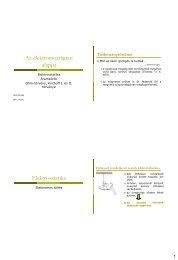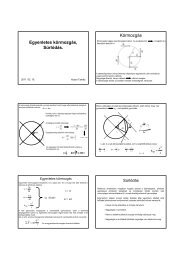Biophysics 1 / Physics-biophysics 1 – theory exam questions
Biophysics 1 / Physics-biophysics 1 – theory exam questions
Biophysics 1 / Physics-biophysics 1 – theory exam questions
You also want an ePaper? Increase the reach of your titles
YUMPU automatically turns print PDFs into web optimized ePapers that Google loves.
<strong>Biophysics</strong> 1 / <strong>Physics</strong>-<strong>biophysics</strong> 1 <strong>–</strong> <strong>theory</strong> <strong>exam</strong> <strong>questions</strong><br />
2011/2012<br />
1 Blackbody radiation. The photoelectric effect: experimental findings and their explanation<br />
2 Rutherford’s experiment, the Rutherford model of the atom. Bohr’s model: Bohr’s postulates,<br />
the Franck-Hertz experiment<br />
3 The quantum-mechanical model of the atom, wave function. Heisenberg’s uncertainty<br />
relationship. Physical meaning of quantum numbers. The Stern-Gerlach and Einstein-de<br />
Haas experiments<br />
4 Electromagnetic waves, the electromagnetic spectrum. Light as a wave and its<br />
characteristics: diffraction, interference, polarization. The dual nature of light. Matter waves<br />
5 Properties of laser light. Mechanism of laser light generation. Components of a laser, laser<br />
types and their applications<br />
6 Properties and spectrum of X-rays. Components and function of an X-ray tube. Types of Xrays<br />
and the mechanisms of their generation<br />
7 Structure and models of the atomic nucleus. Properties of nuclear force, binding energy.<br />
Radioactivity. The radioactive decay law. Half lives<br />
8 Types of radioactive radiations, their properties and interactions with matter. Applications of<br />
radioactive isotopes<br />
9 Biological effect of radioactive radiations. Dose-dependence of radiation effects: doseresponse<br />
curves. Target <strong>theory</strong> and <strong>theory</strong> of the indirect action of radiation. Molecular<br />
<strong>theory</strong> of radiation effects. Factors influencing the effect of radiations<br />
10 Types of thermodynamic systems. Intensive and extensive quantities. The 0th and 1st law of<br />
thermodynamics<br />
11 The 2nd law of thermodynamics. Entropy. Thermodynamic probability, the statistical<br />
interpretation of entropy<br />
12 Thermodynamic potentials: internal energy, enthalpy, free energy, Gibbs-free energy. Change<br />
of thermodynamic potentials during equilibration processes. Chemical potential<br />
13 Diffusion. Fick’s 1st law. Diffusion coefficient. The Einstein-Stokes formula. Fick’s 2nd law.<br />
Diffusion through the cell membrane: passive, active and facilitated diffusion<br />
14 Osmosis. Van’t Hoff’s law. Osmotic pressure and its significance<br />
15 Types of fluid flow. Reynolds number. Viscosity. Laws of fluid flow: continuity equation,<br />
Bernoulli’s law, the Hagen-Poiseuille law, Stokes’ law<br />
16 Structure and characteristics of the circulatory system. Determination of the cardiac output,<br />
the Frank-Starling law. The work of the heart<br />
17 Fundamental physical properties of water. The phase diagram of water. Biological role of<br />
water<br />
18 Definition of macromolecules. Models describing ideal polymer chains: freely jointed chain,<br />
wormlike-chain. Parameters describing mechanical flexibility of polymers<br />
19 Levels of protein structure. Theory of protein folding: Anfinsen’s experiment, Levinthal’s<br />
paradox, the folding funnel model<br />
20 Structure of the cell membrane. Resting membrane potential. The Nernst equation.<br />
Donnan potential. The Goldman-Hodgkin-Katz equation
21 Sensory receptors. Phases of the action potential. Changes of ion fluxes corresponding to the<br />
different phases<br />
22 Structure and function of the eye. Accommodation, vision defects. Properties and function of<br />
photoreceptors. Molecular processes in vision and color vision<br />
23 Sound and its characteristics. Structure and function of the ear. Békésy’s <strong>theory</strong>. Molecular<br />
basis of hair cell function<br />
24 The cytoskeletal system. Types, polymerization, characteristics and mechanical properties of<br />
cytoskeletal filaments. Associated proteins<br />
25 Motor proteins, cellular motility. Common characteristics and types of motor proteins. The<br />
ATPase cycle. Properties, function and partner proteins of the different motor protein types<br />
26 Structure and mechanics of cross-striated muscle. Structure of muscle, the sarcomere and<br />
its building elements. Contractile proteins. Mechanical properties of muscle, velocity<br />
dependence of the force and power of muscle<br />
27 Molecular basis of muscle function and regulation. Types of regulation. Muscle regulatory<br />
proteins and their characteristics. The role of calcium in regulation
<strong>Biophysics</strong> 1 / <strong>Physics</strong>-<strong>biophysics</strong> 1 <strong>–</strong> practical <strong>exam</strong> <strong>questions</strong><br />
2011/2012<br />
Room 1<br />
1 Direct Current measurements<br />
2 Alternating Current measurements<br />
3 Electrical conductance<br />
4 Refractometry<br />
5 Spectroscopy and spectrophotometry<br />
6 Polarimetry<br />
7 Viscosity of fluids<br />
8 Surface tension<br />
9 Adsorption and swelling<br />
10 Centrifugation<br />
11 Electrophoresis<br />
Room 2<br />
1 The Geiger-Müller counter<br />
2 Radioactive half-life<br />
3 Gamma-absorption and spectrometry<br />
4 Absorption of beta-radiation, dead time<br />
5 Scintigraphy<br />
6 Optics. Illumination<br />
7 Absorption photometry<br />
8 Blood pressure. Electrocardiography<br />
9 Ultrasound<br />
10 Temperature measurement<br />
11 Audiometry


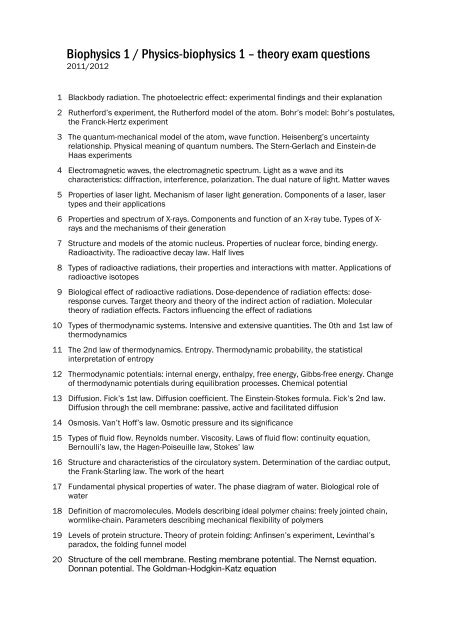
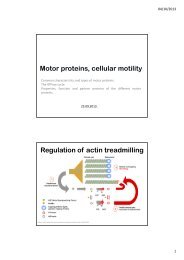
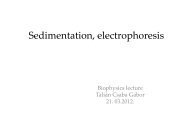
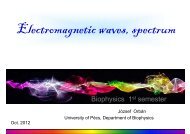
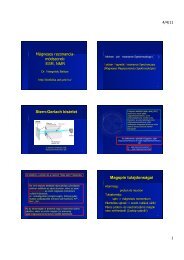
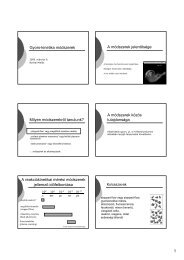
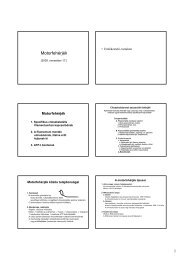





![Microsoft PowerPoint - Intermedier filamentumok [Kompatibilis m\363d]](https://img.yumpu.com/17119137/1/190x135/microsoft-powerpoint-intermedier-filamentumok-kompatibilis-m363d.jpg?quality=85)
